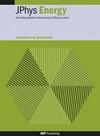A brief introduction of electrode fabrication for proton exchange membrane water electrolyzers
IF 6.3
3区 材料科学
Q1 ENERGY & FUELS
引用次数: 0
Abstract
Proton exchange membrane water electrolyzer (PEMWE) is a major enabler of green hydrogen production. The development of water electrolyzers is a vital step in driving the progress of a hydrogen-based economy. The system inside the electrolyzer is a zero-gap cell featuring low ohmic resistance and boosted mass transport, leading to higher energy efficiency and minimized capital cost. Besides, utilizing PEM in the electrolyzer for sustainable hydrogen production enables the system to perform with many advantages, including superior energy efficiency, higher hydrogen purity, and high flexibility. Therefore, as PEM electrolyzers continue to evolve, sustainable hydrogen production on a larger scale will be realized in the near future. This review summarizes the status quo of PEM water electrolyzers in the past four years. We will start with a brief introduction of the core of a water electrolyzer, namely the membrane electrode assembly (MEA), which will be followed by an introduction of fabrication methods of MEA, including CCM methods, catalyst-coated electrode methods, and other innovative fabrication methods. Next, we will summarize recent attempts to modify electrodes and membranes in MEAs to promote the performance of PEMWE. Subsequently, catalyst development for hydrogen evolution reaction (HER) and oxygen evolution reaction (OER) in MEA is discussed, highlighting novel HER/OER catalysts and strategies to reduce the content of noble metals. Lastly, conclusion and perspectives are provided to present a blueprint to inspire the future development of PEMWE.质子交换膜水电解槽电极制作简介
质子交换膜水电解槽(PEMWE)是绿色制氢的主要推动者。水电解槽的发展是推动氢基经济发展的重要一步。电解槽内部的系统是一个零间隙电池,具有低欧姆电阻和促进质量传输的特点,从而提高能源效率和最小化资本成本。此外,在电解槽中利用PEM进行可持续制氢,使系统具有许多优势,包括卓越的能源效率、更高的氢纯度和高灵活性。因此,随着PEM电解槽的不断发展,在不久的将来将实现更大规模的可持续制氢。本文综述了近四年来PEM水电解槽的发展现状。我们将首先简要介绍水电解槽的核心,即膜电极组件(MEA),然后介绍MEA的制造方法,包括CCM方法,催化剂包覆电极方法和其他创新的制造方法。接下来,我们将总结最近在MEAs中修改电极和膜以提高PEMWE性能的尝试。随后,讨论了MEA中析氢反应(HER)和析氧反应(OER)催化剂的开发,重点介绍了新型HER/OER催化剂和降低贵金属含量的策略。最后,本文给出了结论和展望,为进一步发展PEMWE提供了蓝图。
本文章由计算机程序翻译,如有差异,请以英文原文为准。
求助全文
约1分钟内获得全文
求助全文
来源期刊

Journal of Physics-Energy
Multiple-
CiteScore
10.90
自引率
1.40%
发文量
58
期刊介绍:
The Journal of Physics-Energy is an interdisciplinary and fully open-access publication dedicated to setting the agenda for the identification and dissemination of the most exciting and significant advancements in all realms of energy-related research. Committed to the principles of open science, JPhys Energy is designed to maximize the exchange of knowledge between both established and emerging communities, thereby fostering a collaborative and inclusive environment for the advancement of energy research.
 求助内容:
求助内容: 应助结果提醒方式:
应助结果提醒方式:


